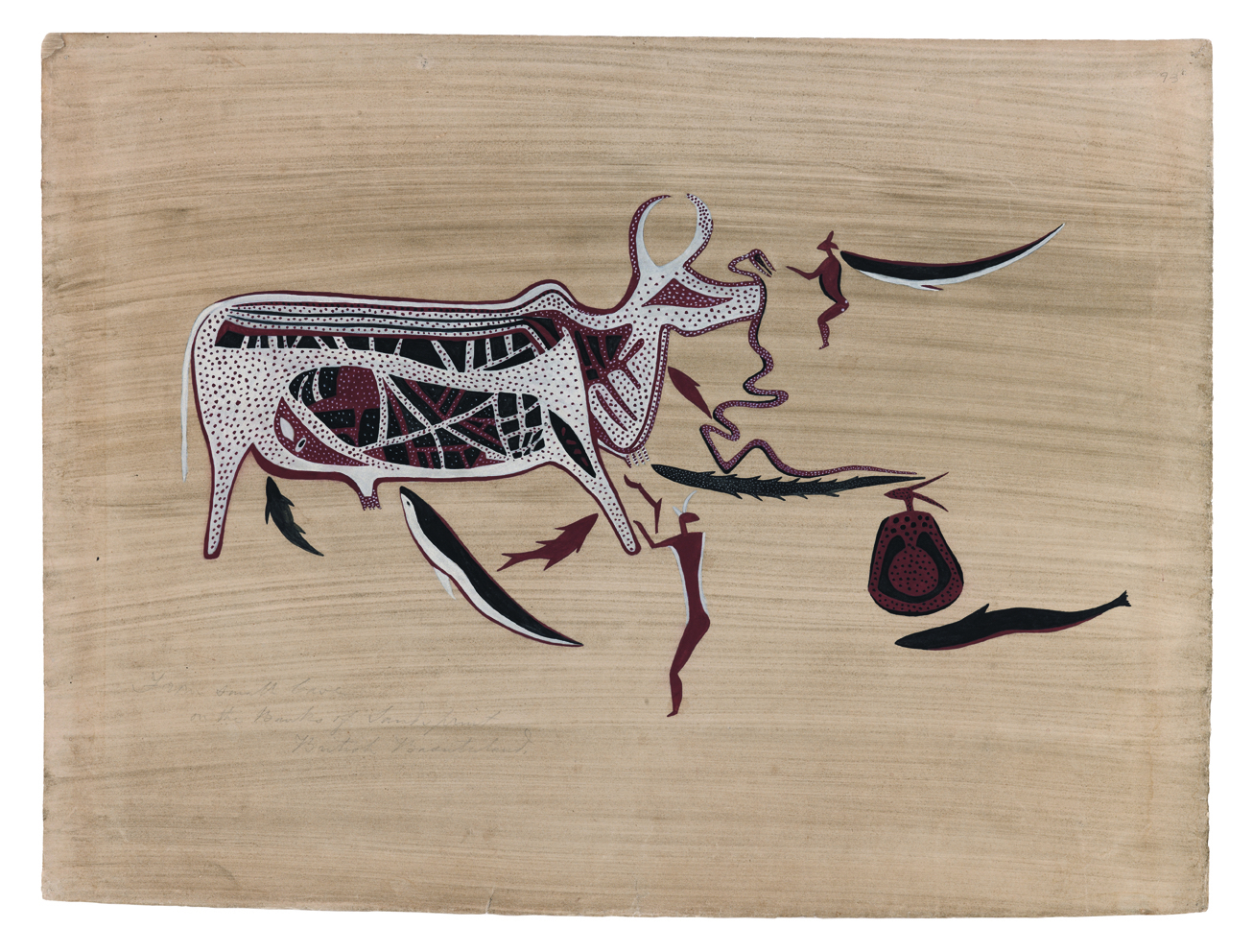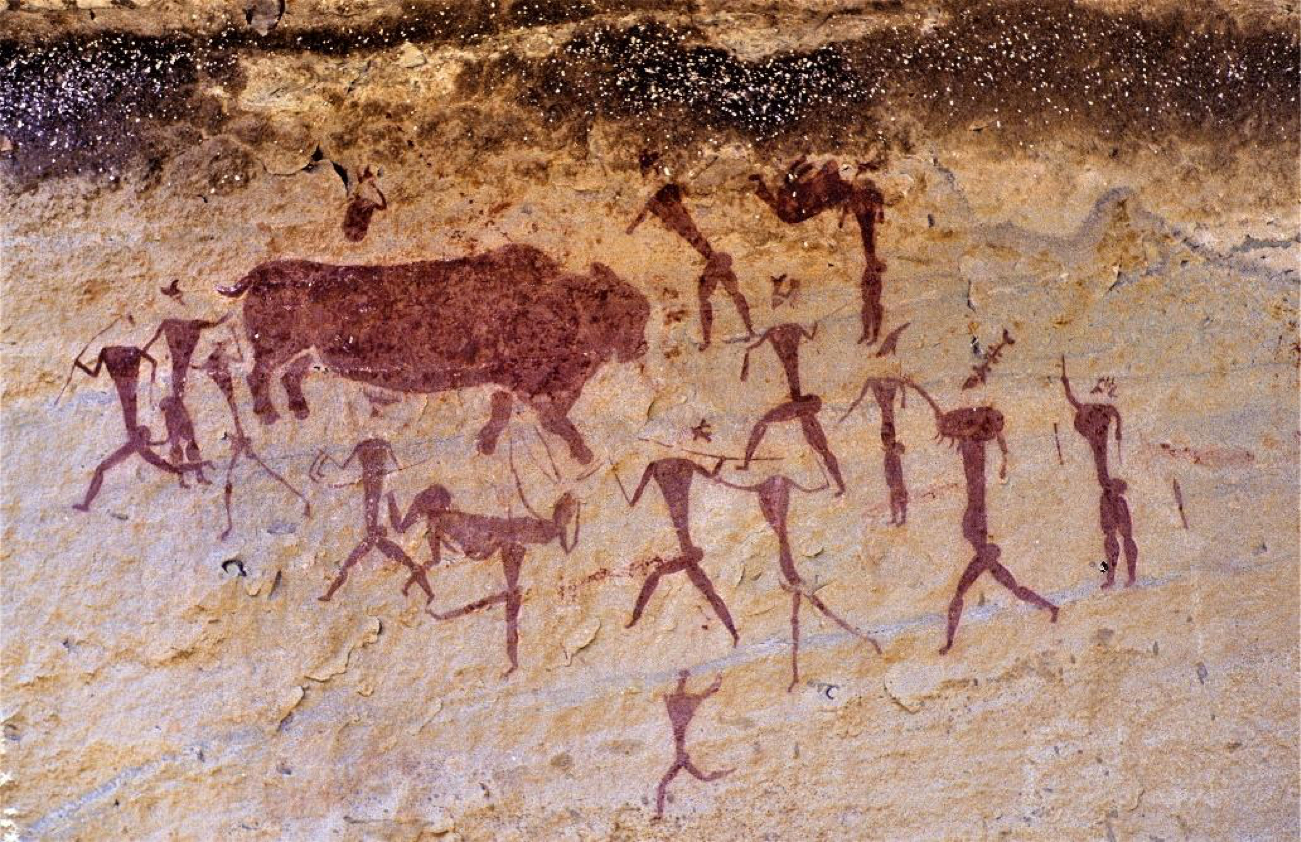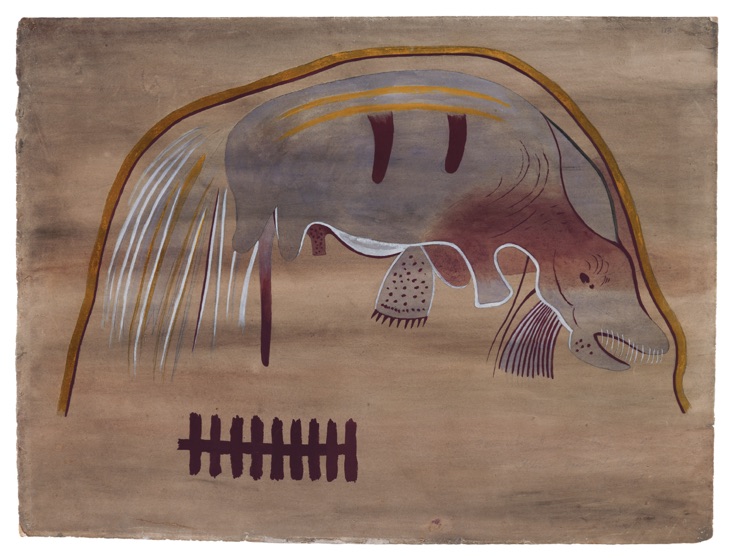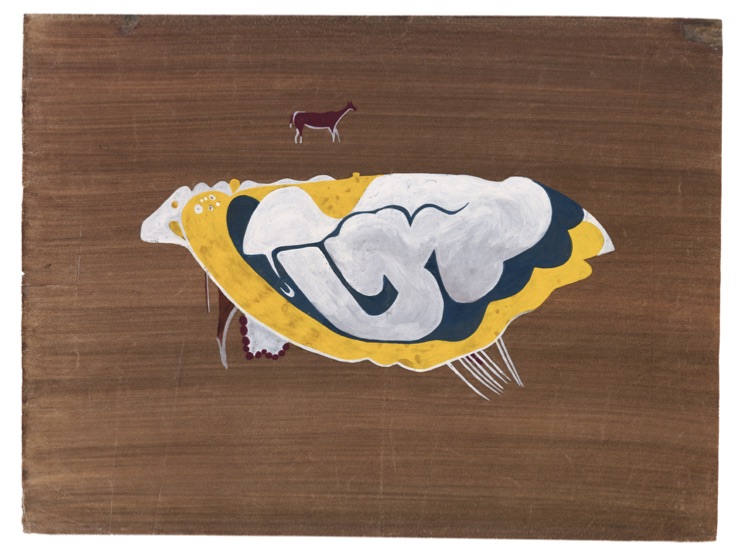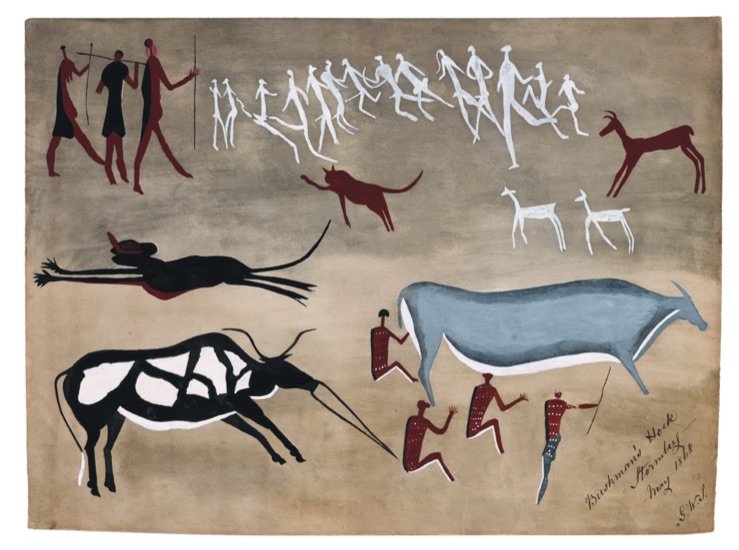In the |xam philosophy, phenomena can be good or bad, but often they are both. For example, the creator figure, |kaggen, made the world and could even revive the dead; yet he is no paragon of virtue and is often childishly malicious and vengeful. Just as the powerful can use their strength to do good, so they can turn it to ignoble and antisocial ends.
Along with the figure of |kaggen, there is another being who encapsulates the inherent ambiguity of power: !khwa, the embodiment of rain and the water in the waterholes. Rain and water are the essence of both life and death. Female rain falls gently and rejuvenates the arid landscape of the Northern Cape, which today receives only eight inches of rain per year, on average. The stormy male rain, however, is a menace. It floods the shelters of the people and its lightning bolts are lethal.
!khwa, the Rain Bull, is a shadowy but important figure in the |xam texts. His name simply means ‘water’ or ‘rain’. He lives in the waterhole – in fact he is the water in the waterhole – but also traverses the sky as a rain cloud, conceived of as an eland bull. The streams of rain emanating from the cloud are his legs, on which he strides across the landscape. The imprint of raindrops in the sandy earth are the rain’s footprints. The female rain’s footprints are broad and shallow, those of the male rain narrow and penetrating.
Curation details
Online from: 18 Nov 2021
References
Strangely, given the importance of rain, !khwa himself is not an especially prominent figure in the narratives, although his power and presence may be implicit in the numerous accounts that deal with rain and water. For example, various creatures, including some snakes and birds, chameleons, water tortoises and other creatures, are described as ‘rain’s things’, or as belonging to the rain (or water, since the term is the same). It could be that this term merely means that they are associated with watery habitats, but there are hints that some of these creatures are associated with the death-dealing powers of !khwa himself and are somehow his allies and agents.
!khwa’s principal appearances in the narratives are in those concerning young female initiates (‘new maidens’) who disobey the restrictions imposed upon girls at puberty, including seclusion in a special hut and particular dietary requirements. A girl who is tired of the special food she is given goes to the water and kills a water’s child to eat. !khwa, in the form of a whirlwind, envelops her and her family and takes them into the waterhole. Girls who meet this fate are seen as frogs, or as the reflection of stars upon the water’s surface. The need for girls to enter seclusion is because ‘When she is a maiden she has the rain’s magic power’, and if she misbehaves, or ‘scolds’ others and snaps her fingers at them (apparently like the sound of thunder or lightning), then !khwa is angered and becomes stormy.
But it is not only young women who are a social threat, though the emphasis on dangerous femininity is clear (with implications for understanding gender and power in these groups). In one story, a boy was scolded by his sister, a new maiden, and her actions prompted the Rain’s wrath. In a sequel to this story, that same boy was out on the hunting grounds when the Rain appeared, but the boy could not placate him. The rain destroyed the tree under which the boy was sheltering and turned him into a porcupine. Similarly, a man out on the hunting grounds shot !khwa with his arrows, believing him to be an eland. It escaped, so the man returned with others the following morning, and they found it and cut it up. But when they put the meat on the fire, it evaporated. They were shut into their hut by the Rain and thereafter, as was the fate of disobedient new maidens, turned into frogs.
The character of !khwa is mysterious. He is a force in the lives of people and, though the stories of his behaviour concern people of the Early Race, who belong to the mythical creation days, he is not himself a being of those times but an ever-present threat. The stories of |kaggen and the creation days deal with a time when creation was incomplete; people and animals had not been separated and people had not yet learnt social mores, manners and decorum. The subtext in stories of !khwa is primitivity and reversion. (This may be why the creatures that are ‘the rain’s things’ are almost all reptilian or other lower order animals.) The theme of reversion may indirectly reference the old days before culture, sociality and civility came into being at the end of creation. When drowned in the water, errant girls become frogs, her family’s arrows revert to unworked sticks, and leather quivers become animals again.
Again we see the ambiguity embraced in the |xam philosophy. Water is a place of death but a source of life. !khwa is the punisher of transgressors, but he is not himself a saintly figure. Comparisons can perhaps be drawn with the lesser god in the lore of the Kalahari Ju’/hoansi. They told of a ‘great god’ and a ‘lesser god’ – associated with creation and death, and east and west, respectively – who sometimes worked together. However, in the |xam texts |kaggen and !khwa never appear in the same narrative.
The theme of rain is one of few firmly identified in southern African rock art. It was not only in the arid northern Cape that rain was important; paintings in the Ukhahlamba-Drakensberg (where thunderstorms of terrifying force occur throughout the summer) and elsewhere indicate that the rain was as important in other environments (though rain and rain rites play a negligible role in the lore of Kalahari San peoples (Marshall 1999, Solomon 2011)). Nineteenth century commentators (the |xam and, in Lesotho, Qing to JM Orpen) identified rain-related imagery in rock art. The primary importance of the rain in the art was highlighted by Woodhouse, whose 1992 book on the topic includes various copies of paintings made by Stow that depict rain animals and imagery linked to the rain theme.
Paintings figuring control of the rain depict rain animals and human figures. Often the rain animal is an eland; female animals represent gentle, regenerating rain. Other rain animals are herbivore-like imaginary creatures, not depicting actual antelope species. Some may depict !khwa himself and efforts to contain his ferocious power.
The |xam variously described how the rain’s power might be counteracted or rainfall summoned. According to Dia!kwain, people ‘when they perceive that the rain seems as if the rain would become angry, they arise, they go out in front of the house, they stand [?opposite] to the place from which the rain comes. And they strike their [?navels] with their fists, and they press their hand on their navel and they snap their fingers at the rain. And they speak to the rain, and they speak, they say, “thou shall falling turn back”….’.
|han≠kass’o said that ‘The rain is addressed in the following manner by the old men: first they speak to the dead men who are with the rain. “O gallopers/ O gallopers/ Do you not know me?/ You do not seem to know my house.’ Dia!kwain told of his father asking a dead man named !nuin-|kuiten for rain: ‘“You are !nuin-|kuiten, who said to me at the time when you were dying [translated by Dorothea Bleek as ‘dead’], that if I pray to you, you would pity me, you would make rain fall for me.” And when father spoke thus the rain clouds came gliding up, they kept on gliding up, the rain did not come up slowly, but the rain clouds covered the sky.’Accounts of rain ‘sorcerers’ (!gi-ten) are interpreted by some (e.g. Lewis-Williams 1980) as describing the activities and hallucinatory experiences of ‘shamans’, but these commentaries suggest that rain !gi-ten were in fact dead kin who could be called upon by the living for assistance. The |xam themselves no longer made rock art, and verbal addresses to the spirits were made, though not always successfully. The boy who was turned into a porcupine tried to implore the rain for mercy but ‘the rain would not allow him to speak with the rain’. Rain paintings may have been made as a way of asking spirit-kin for help rather than serving as recollections of alleged shamanic rituals (e.g. Solomon 2008, 2017).
The elusive !khwa is a tantalising but shadowy presence in the |xam texts. Though collected a century later, and perhaps bearing the mark of Khoe traditions, testimonies gathered by Ansie Hoff (e.g. Hoff 2011) from areas close to the |xam home territory tell of a wealth of water lore and of worlds beneath the water. The |xam narratives and accounts are surely only part of a more complex web of ideas, lingering but now largely lost. Stories and rock art nevertheless attest to the potency of the rain, woven through all aspects of people’s lives.




